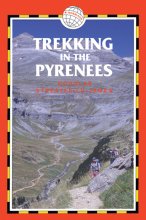Trailblazer guidebooks provide practical information on specific routes in less accessible parts of the world.
— Wanderlust

Trekking in the Pyrenees
Excerpt:
Route options
Contents List | Introduction | Route options | Planning your trek | Eating and Drinking - Pyrenean Style | Sample Trek

The route that you choose will depend on your level of experience, the time available, and what you particularly want to see. There are a variety of footpaths through the mountains but worthy of special mention are the three trans-Pyrenean routes. For an overall route map see inside back cover.
Grande Randonn�e (GR) 10
The GR10 is one of the network of French long-distance paths which cover much of the country. Generally, these routes are well marked and maintained by local volunteers, and the GR10 is no exception. Throughout its 700km course from the Atlantic to the Mediterranean there are only a few places where route-finding causes any real difficulty. Likewise in all but a few areas, the GR10 is well supplied with facilities en route. Day stages tend to start with a climb out of a valley and end with a descent into another valley in order to reach a g�te d��tape or guest house where walkers can stay the night. For many, this may sound unlike what they had in mind, and indeed, during the mid-summer holiday there can be a lot of people following the same path. There are, however, benefits: route finding is scarcely ever a problem, leaving plenty of time to enjoy the scenery. If you're walking by yourself and concerned about the safety aspects, it can be reassuring to know that the path you are following is relatively well trodden, and that if you encounter a problem you will most probably be able to get help from fellow walkers. Finally, since there are good facilities along the way, there's no need to carry your life on your back. You can really keep the weight to the minimum and know that you've got somewhere to stay in the evening.
Gran Recorrido (GR) 11
The GR11 is the Spanish coast to coast path which runs through the mountains of Navarra, Arag�n and Catalonia. it's much newer than the GR10, and passes through countryside which is far wilder and more remote. There are fewer villages and practically no lodges on the way, so camping and carrying several days’ worth of provisions are necessary. The route is, by and large, well marked but route-finding is made trickier by the inaccuracy of the Spanish maps. Nonetheless, the GR11 passes through some incredibly beautiful areas and has much to recommend it.
Haute Randonn�e Pyr�n�eNne (HRP)
The HRP is the classic high-level coast to coast route. It attempts to follow the ridge of the mountain range from Atlantic to Mediterranean, crossing between France and Spain as the land dictates. Trekkers on the HRP may still find snow in the high passes in early to mid-June, and an ice axe is necessary in certain places in early summer. There are few places where the route descends to the valleys, so that food and a tent must be carried throughout. The HRP should be attempted only by experienced mountain trekkers.
High-route walkers tend to be rather dismissive of the GR10 (tranquille is the word they use) and there's no doubt that the scenery is much wilder and more mountainous along the HRP than on the lower paths. In some ways, ironically, the GR10 is harder work; the HRP tends to stay on the ridge of the mountains, only coming down where necessary, whereas the GR10 literally climbs and descends into every valley in order to stay much closer to civilization.
OVERALL
Walkers intent on trekking from coast to coast tend to decide on one or other of the three options above and to follow the route religiously. This is as much for practical reasons as for others: there are separate guidebooks for each of the routes, and few maps show all three routes in relation to each other. There's no reason why, with a little planning, you shouldn't take the best of each route. I met a group of walkers who had hired a guide to take them on an individual route across the Pyrenees, combining elements of the GR10, GR11 and HRP as seemed most interesting at the time.
This book gives a complete description of the GR10 (ie all the stages from the Atlantic to the Mediterranean) and also describes about two-thirds of the GR11. In addition, connections with some of the best sections of the HRP are included, as are a few interesting variants and suggested itineraries. Of course it's impossible to cover all the options, and the most interesting way to travel is also to do a bit of exploring for yourself off the beaten track.
Latest tweets